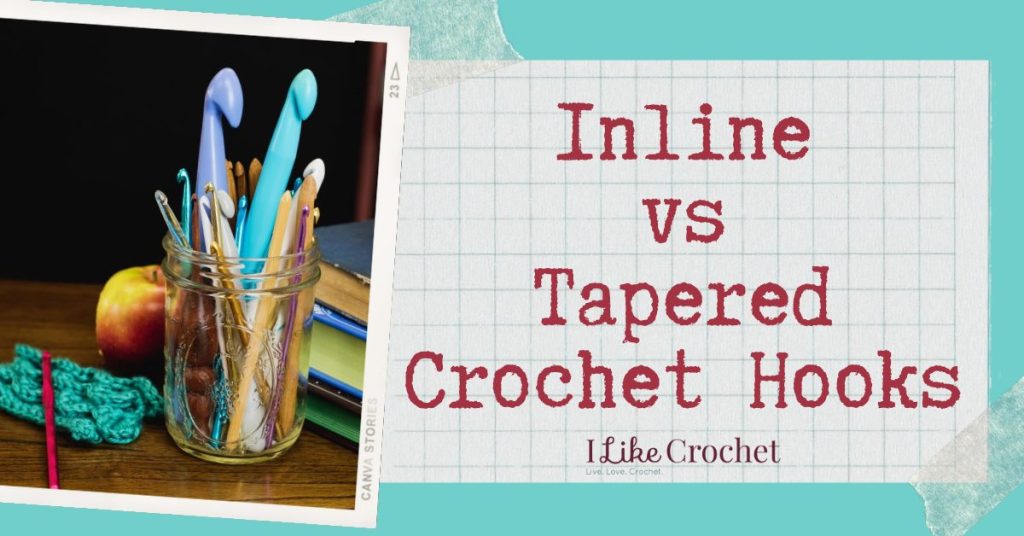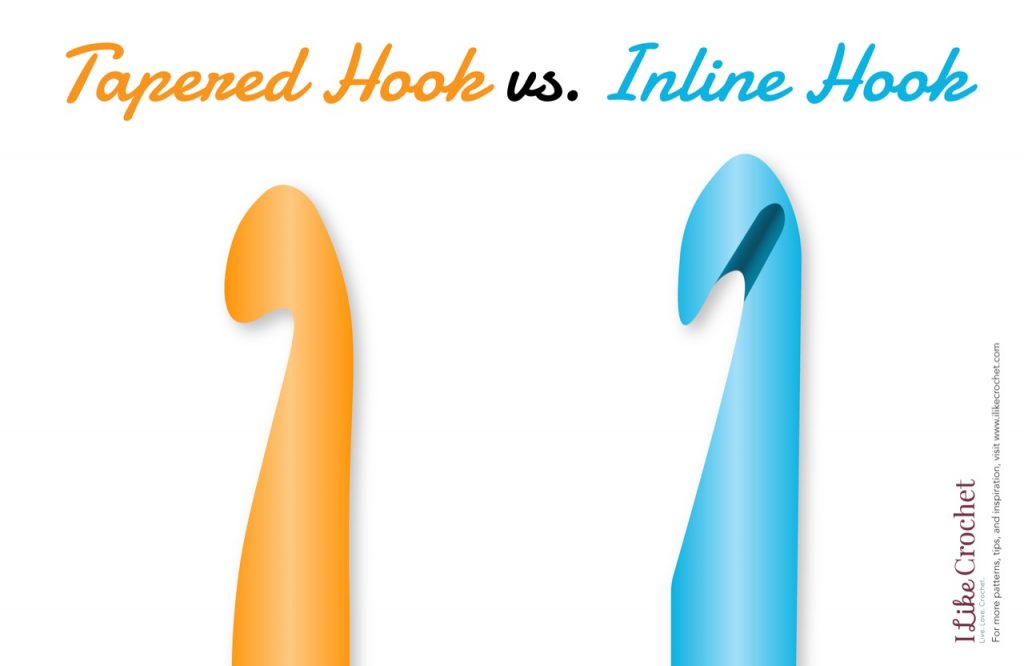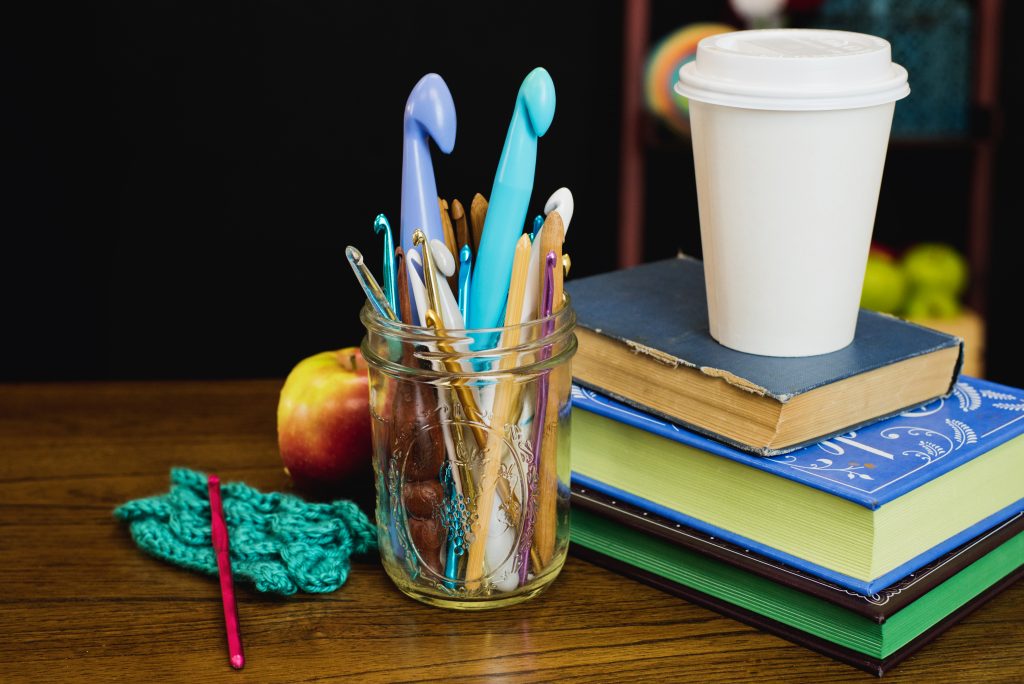
Discover the best crochet hooks to use as we answer the age-old debate on the inline vs tapered crochet hook. The answer to this question may surprise you! Crocheters all have their preferences as to which hook feels better. Learn why some people prefer one hook over the other.
I’m pretty sure the inline vs tapered crochet hook debate has been going on in the crochet world since the introduction of both hooks. If you delve into the madness, you will find pretty heated arguments for or against each hook style since both have very loyal followers.
This hook holds the yarn better! This one is less stress on your wrist! This hook helps you maintain a consistent tension!
Someone new to crochet could go crazy reading the pro/con lists before choosing a hook.
But I’m going to end this argument once and for all by letting every new crochet artist in on the best kept secret in regards to hook style: it actually doesn’t matter which one you use.
Learning crochet really doesn’t have much to do with buying the perfect hook as much as it has to do with muscle memory.
The reason you feel so awkward when you start, quite simply, is because your hands are not used to movements. No matter which hook you start with, when you make your very first row of single crochet, you are going to feel like a monkey playing with a stick. But keep working and you’ll find that the very second your hand ‘memorizes’ the motion, your tension will get more consistent, your stitches will become neater, and your finished objects will begin to look amazing.
It’s no coincidence that people who advocate so hard for inline vs. tapered just happened to have learned to crochet with one of those hooks. Of course the first hook they picked up and forced themselves to work with through the growing pains of muscle memory is going to be the ‘best’ one.
Your hand will adapt to your tools. Not the other way around.
So which hook should you choose?

To answer that question, I’m going to digress a bit to talk about stitch markers. There was a point in my crochet life where you couldn’t pay me to use a stitch marker. I had different colored pieces of yarn, safety pins and even those plain little rings at the ready, but I just wouldn’t use them. I didn’t want to break my rhythm and I rationalized that I could remember where the stitch marker should be.
Well, you can guess what happened next, right? Every single project slanted wrong or didn’t fit or ended up needing to be frogged it was so hopelessly messed up. Still, I wouldn’t use them. THIS time I’ll just remember, I told myself. THIS time I won’t NEED to mark the stitch.
Then one day I was reading a crochet discussion online about something totally unrelated and a post someone made really struck me. Loosely paraphrased, she said, “You’ll want to make beautiful things if you use beautiful tools.”
I decided to test her theory with my aversion to stitch markers. I ditched all my plain or homemade stitch markers and searched online to find some beautiful crystal charm stitch markers.
The change in my crocheting was immediate.
I went from avoiding stitch markers like the plague to seeking out patterns specifically so I could use them. Something about seeing those gorgeous crystals dangling delicately from my yarn warmed my heart, so placing them became a joy instead of a chore.
Now, let’s return to the question of which hook you should use.
And I will answer that question now in the simplest way that I can: pick the hook that you find most aesthetically pleasing. After all, you’ll want to make beautiful things if you use beautiful tools.




I think the way you hold your crochet hook impacts which hook works best for you. I am a die-hard in-line crocheter but I hold my hook very differently from my friends who prefer the tapered hook. As was stated, IT DOES NOT MATTER which hook you use as the end result is the same.
Happy crocheting!
I began my crocheting career at the hands of my maternal grandmother who taught me the absolute basics of crochet when I was 8 years old; a slip knot, slip stitch, single crochet, & chain. I used a Boye size G tapered hook until I became an adult and could purchase my own supplies. At 18 I discovered Susan Bates inline Silvalume hooks and have remained a die-hard fan ever since. I do buy others for specific projects such as afghans with 4 colors of yarn held together which require quite large plastic hooks and aren’t available in Silvalume but as for the type, be it metal, plastic, wood, …, I will forever remain an inline fan.
I have been crocheting since I was 20 I’m now 83 and only use Susan Bates.
I learned, I guess, on tapered hooks, using my mother’s. They were all grey aluminium and tapered. I inherited her collection. One day I saw a set of coloured aluminium and was hooked (pun intended). They were BOYE brand and have used these for 10 years now. I had never heard of inline. When I lost my I (5.5) hook, I tried to replace it but Boyenow makes I in 5.25 so I tried buying other brands online. The only one I could find at the time was an acrylic one. When it arrived, it was inline but I only noticed after trying to use it and it was impossible. My darling husband found my favourite 5.5 hook! Disaster averted.
My Gma taught me to crochet when I was 8 or 9 and I enjoyed learning it from her. I lost how to do it but took a community education class and by the second class my muscles remembered how to do it and I was doing it faster then everyone in the class. But I can’t remember what hooks she used. But I prefer inline cause it goes through the spaces easier then the other.
My great aunt gave me an “F” hook 60 years ago when she taught me to crochet. My first project was a granny square afghan. I still have the afghan and that crochet hook is still my favorite.
My taught me to crochet when I was 8-9 years old back in the sixties. She used inline hooks, so that was what I got used to, and even down to a certain brand. Though, that brand has changed for the worse since getting made out of the country, it splits the yarn more, however, I still remain brand loyal. When I get tapered hooks, I pass them on to a friend.
Agree that the one you learned on will always be the favorite. My first project was a Laurel wood with the flat thumb hold. To this day, I use wooden hooks 90% of the time. Most used hook size is F because I love fingering/ sock weight the best, too.
I learned to crochet with tapered hooks. About 5 years ago my granddaughter who was 8 at the time wanted to learn so we went shopping for yarn and hooks. I had seen one of my favorite designers using inline hooks so I thought I would give them a try. I loved them from the first minute. A year or so later I couldn’t find one of my inline hooks so I tried using a tapered hook. After about 30 minutes I was so frustrated because the yarn just kept slipping off the hook and I was having to go so slow I gave up until I could find my inline hook.
My stitch markers are safety pins!!! Everything I use a article marker it ends up breaking the pins don’t!!! As for my hooks I’m a diehard tapered hook user!!!
I use colored plastic coated paperclips.
I have used both, but my preference is the inline hook because I tend to crochet tighter than most. For years now, I have made a conscious effort to not crochet so tightly and the inline hook helps me to keep my stitches more loose. The tapered hook allows me to make my stitches too tight, even when trying to make a conscious effort to not do so. For me, Susan Bates hooks all the way!
I can appreciate the comment about the tools but rather seeking beauty, I have learned to seek quality. I had purchased a crochet kit from Amazon when I returned to crochet after a 50 year hiatus. The stitch markers in that kit snagged on the fabric because the flashing from the molding process hadn’t been properly removed. I picked up some Clover stitch markers and they are smooth as silk. Same with the Clover hooks. I don’t need beauty so much as I appreciate quality and the Clover hooks work for me. We all need to use what works for each of us individually though and we will make up our own minds in the end, which I think is your point.
What are these crystal markers you use. Sounds interesting. Sometimes I use mini safety pins as markers on less delicate projects. If it is a project using fine thread cotton as used for edges I use a piece of coloured fine cotton. A safety pin type marker could ruin a delicate project.
Can you show me what the crystal markers look like
Much appreciated
Rose Anderson
Hello Rose! Likely, her stitch markers were something like these: https://www.etsy.com/search?q=crystal%20stitch%20markers
Hope that helps! – Nicola, Editor
I use bobpins for markers. Hooks I have mine and my mother’s so I use the one that makes me happy to use at the moment.
I taught myself to crochet using an in-line hook, and for decades that’s what I used. My daughter convinced me to try a tapered hook when I became so frustrated at a yarn that was so very “splitty”. I became a convert to tapered hooks because the sharp edge of the in-line edge seems to split the yarn more than tapered.
I agree so much! There is a particular size of hook I use most frequently, and I have 3 different hooks of that size (left over from the days I was teaching a couple friends to crochet, and we each used a different color to tell our work apart). I always search my hook bag for the shiny red one. Forget the green or blue. I love the red one. I have even modified patterns to be able to use this hook instead of a different size because I like it better.
I love the stitch marker conversation ????! I am going to take your advice and find some lovely stitch markers!!
I made some for myself a while back using some jewelry stuff that I had.